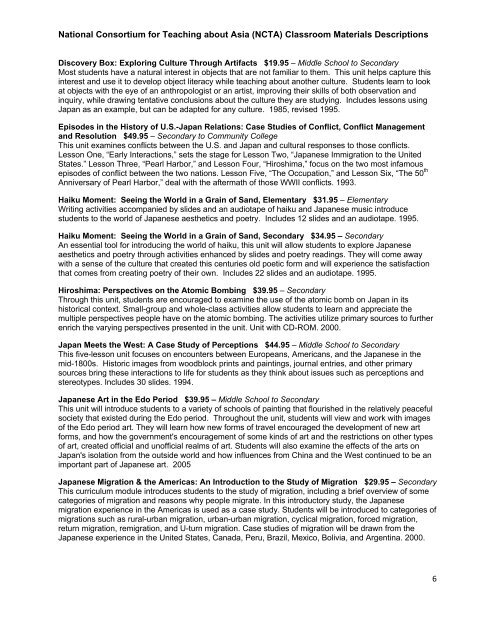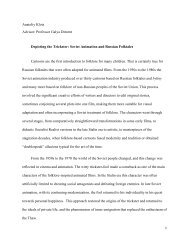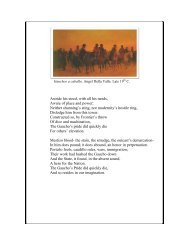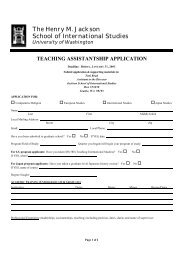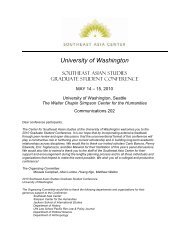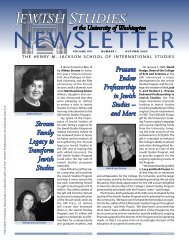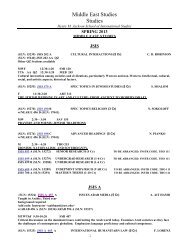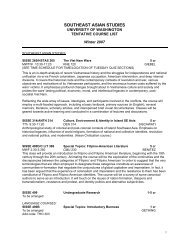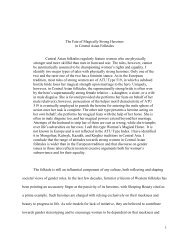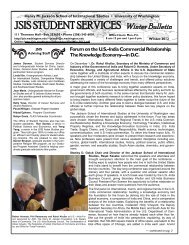Cobblestone Publishing Kamishibai for Kids - Jackson School of ...
Cobblestone Publishing Kamishibai for Kids - Jackson School of ...
Cobblestone Publishing Kamishibai for Kids - Jackson School of ...
Create successful ePaper yourself
Turn your PDF publications into a flip-book with our unique Google optimized e-Paper software.
National Consortium <strong>for</strong> Teaching about Asia (NCTA) Classroom Materials Descriptions<br />
Discovery Box: Exploring Culture Through Artifacts $19.95 – Middle <strong>School</strong> to Secondary<br />
Most students have a natural interest in objects that are not familiar to them. This unit helps capture this<br />
interest and use it to develop object literacy while teaching about another culture. Students learn to look<br />
at objects with the eye <strong>of</strong> an anthropologist or an artist, improving their skills <strong>of</strong> both observation and<br />
inquiry, while drawing tentative conclusions about the culture they are studying. Includes lessons using<br />
Japan as an example, but can be adapted <strong>for</strong> any culture. 1985, revised 1995.<br />
Episodes in the History <strong>of</strong> U.S.-Japan Relations: Case Studies <strong>of</strong> Conflict, Conflict Management<br />
and Resolution $49.95 – Secondary to Community College<br />
This unit examines conflicts between the U.S. and Japan and cultural responses to those conflicts.<br />
Lesson One, “Early Interactions,” sets the stage <strong>for</strong> Lesson Two, “Japanese Immigration to the United<br />
States.” Lesson Three, “Pearl Harbor,” and Lesson Four, “Hiroshima,” focus on the two most infamous<br />
episodes <strong>of</strong> conflict between the two nations. Lesson Five, “The Occupation,” and Lesson Six, “The 50 th<br />
Anniversary <strong>of</strong> Pearl Harbor,” deal with the aftermath <strong>of</strong> those WWII conflicts. 1993.<br />
Haiku Moment: Seeing the World in a Grain <strong>of</strong> Sand, Elementary $31.95 – Elementary<br />
Writing activities accompanied by slides and an audiotape <strong>of</strong> haiku and Japanese music introduce<br />
students to the world <strong>of</strong> Japanese aesthetics and poetry. Includes 12 slides and an audiotape. 1995.<br />
Haiku Moment: Seeing the World in a Grain <strong>of</strong> Sand, Secondary $34.95 – Secondary<br />
An essential tool <strong>for</strong> introducing the world <strong>of</strong> haiku, this unit will allow students to explore Japanese<br />
aesthetics and poetry through activities enhanced by slides and poetry readings. They will come away<br />
with a sense <strong>of</strong> the culture that created this centuries old poetic <strong>for</strong>m and will experience the satisfaction<br />
that comes from creating poetry <strong>of</strong> their own. Includes 22 slides and an audiotape. 1995.<br />
Hiroshima: Perspectives on the Atomic Bombing $39.95 – Secondary<br />
Through this unit, students are encouraged to examine the use <strong>of</strong> the atomic bomb on Japan in its<br />
historical context. Small-group and whole-class activities allow students to learn and appreciate the<br />
multiple perspectives people have on the atomic bombing. The activities utilize primary sources to further<br />
enrich the varying perspectives presented in the unit. Unit with CD-ROM. 2000.<br />
Japan Meets the West: A Case Study <strong>of</strong> Perceptions $44.95 – Middle <strong>School</strong> to Secondary<br />
This five-lesson unit focuses on encounters between Europeans, Americans, and the Japanese in the<br />
mid-1800s. Historic images from woodblock prints and paintings, journal entries, and other primary<br />
sources bring these interactions to life <strong>for</strong> students as they think about issues such as perceptions and<br />
stereotypes. Includes 30 slides. 1994.<br />
Japanese Art in the Edo Period $39.95 – Middle <strong>School</strong> to Secondary<br />
This unit will introduce students to a variety <strong>of</strong> schools <strong>of</strong> painting that flourished in the relatively peaceful<br />
society that existed during the Edo period. Throughout the unit, students will view and work with images<br />
<strong>of</strong> the Edo period art. They will learn how new <strong>for</strong>ms <strong>of</strong> travel encouraged the development <strong>of</strong> new art<br />
<strong>for</strong>ms, and how the government's encouragement <strong>of</strong> some kinds <strong>of</strong> art and the restrictions on other types<br />
<strong>of</strong> art, created <strong>of</strong>ficial and un<strong>of</strong>ficial realms <strong>of</strong> art. Students will also examine the effects <strong>of</strong> the arts on<br />
Japan's isolation from the outside world and how influences from China and the West continued to be an<br />
important part <strong>of</strong> Japanese art. 2005<br />
Japanese Migration & the Americas: An Introduction to the Study <strong>of</strong> Migration $29.95 – Secondary<br />
This curriculum module introduces students to the study <strong>of</strong> migration, including a brief overview <strong>of</strong> some<br />
categories <strong>of</strong> migration and reasons why people migrate. In this introductory study, the Japanese<br />
migration experience in the Americas is used as a case study. Students will be introduced to categories <strong>of</strong><br />
migrations such as rural-urban migration, urban-urban migration, cyclical migration, <strong>for</strong>ced migration,<br />
return migration, remigration, and U-turn migration. Case studies <strong>of</strong> migration will be drawn from the<br />
Japanese experience in the United States, Canada, Peru, Brazil, Mexico, Bolivia, and Argentina. 2000.<br />
6


